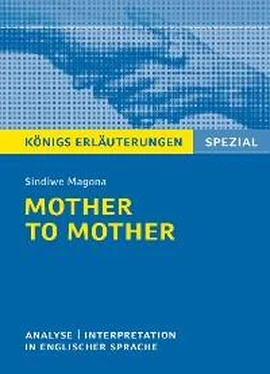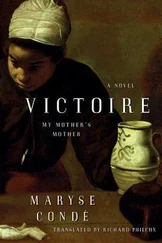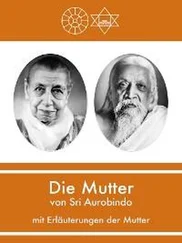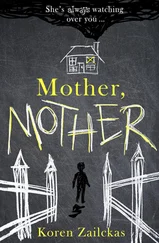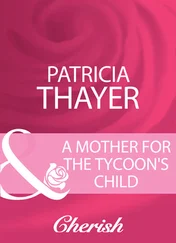Characters:
Mandisa and her son Mxolisi are central to everything that happens and everything the novel is about.
Mandisa
the narrator, mother of three children
she became accidentally pregnant when she was 14
Mxolisi
Mandisas eldest son, who kills the white girl
Lunga and Siziwe
Mandisas second son and her daughter
China, Lungile & Dwadwa
Mandisa’s three husbands and the fathers of her children
Mandisa’s extended family(Mama, Tata, Khaya, et al.)
Other characterslike Chinas family, Mandisas friends and neighbours or the white girl and her mother
Themes:
The themes we will look at in this study guide are issues of identity and inequality: violence and oppression; communities, families and traditions; and grief, guilt, hope and despair. There is a larger theme behind all of these which organises the structure of the narrative, and that is an investigation of the past.
Style and language:
The style of the novel moves between a clear and direct address (from “me” to “you”) and a richer, poetic style. The language is an interesting combination of unusual English diction and structures and a mixture of the various languages people of Mandisa’s status would speak – English, Afrikaans and Xhosa.
Interpretations:
Mother to Mother can be interpreted and read as both an informative, semi-autobiographical fictionalised account of the killing of Amy Biehl and as a look at bigger historical issues and symbolism.
| 2. |
Sindiwe Magona: Leben und Werk |
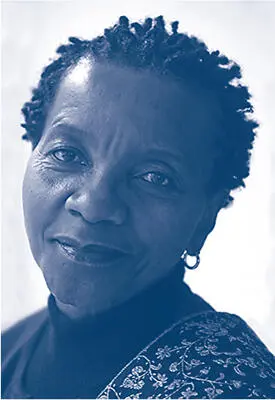
Sindiwe Magona (*1943)
© picture alliance/Scanpix TT NEWS AGENCY
| YEAR |
PLACE |
EVENT |
AGE |
| 1943 |
Gungululu (village in what is now called the Eastern Cape, formerly Transkei), South Africa |
27 August: Sindiwe Magona is born, eldest of eight children |
|
| 1962 |
Gugulethu |
She works for years as a junior school teacher. |
19 |
| 1966 |
Gugulethu |
Already the mother of two children, Magona is now pregnant with a third when her husband leaves the family. |
23 |
| 1981 |
Gugulethu |
Completes a graduate degree (her third academic degree) from Columbia University (USA) via post. |
38 |
| 1980s–2000s |
New York, USA |
Magona moves with her family to New York to work at the United Nations. |
Late 30s–60 |
| 1993 |
New York |
Awarded an Honorary Degree in Humane Letters by Hartwick College in Oneonta (New York State, USA). |
50 |
| Up to 1994 |
New York |
Works for the UN, presenting anti-apartheid radio programmes. |
51 |
| 1990 |
Cape Town, South Africa |
Publication of the first part of her autobiography To My Childrens Children. |
47 |
| 1998 |
Cape Town |
Mother to Mother was published. |
55 |
| 2003 |
New York/Cape Town |
Magona has been working for the UN’s Public Information Department before retiring in 2003 and moving back to South Africa. |
60 |
| 2003–now |
Cape Town |
Writer in Residence at the University of the Western Cape in Cape Town; also works for Georgia State University (USA). |
|
| 2007 |
South Africa |
In this year, Magona is awarded several major prizes. She is presented with the Lifetime Achievement Award for her contributions to South African Literature, as well as other prizes recognising her literary work, her social activism and her efforts to promote and celebrate Xhosa culture. |
64 |
| 2012 |
South Africa |
2012 she is joint winner with Nadine Gordimer of the Mbokodo Award in Creative Writing.[1] |
69 |
| 2.2 |
Zeitgeschichtlicher Hintergrund |
ZUSAMMENFASSUNG
Mother to Mother is set in the Western Cape province of South Africa and covers a period from the early 1970s up until 1993.
The book describes the era and aftermath of apartheid in South Africa and is the real world backdrop to the murder of Amy Biehl in August 1993.
Mother to Mother is set in the Western Cape provinceof South Africa and covers a period from the early 1970s up until 1993. The story is largely situated in a black township near Cape Town called Guguletu. Other locations include the squatters’ settlement of Blouvlei, where Mandisa grew up, and her ancestral village Gungululu, where her grandmother still lives. All the African characters in the novel belong to the Xhosa people, and we see many examples of tribal customs and traditions.
The book describes the era and aftermath of apartheid in South Africa, a period of extreme racial oppression, state neglect, police brutality and political turmoil and violence. This is the real world backdrop to the murder of Amy Biehl in August 1993(see p. 32); the novel is a fictionalised account of the killing.
Geography
Guguletu
The majority of the book – and the entirety of its present-day time frame, in 1993 – is set in the township of Guguletu, which is 15 kilometres outside Cape Town, in the Western Cape province of South Africa. Today Guguletu has a population of over 98,000, and more than 98% are black African s. The primary language spoken in the township is Xhosa.
Guguletu (which comes from the Xhosa phrase for “our pride”, igugu lethu) was founded in the 1960s as a home for the black people of the Cape Town district of Langa. During apartheid, blacks in the region were not allowed to live in Cape Town and were forced to live in one district, which became desperately overcrowded. Residents were relocated to Guguletu and other newly-founded townships, where overcrowding, lack of education , jobs and adequate infrastructure(electricity, running water, waste removal, etc.) greatly increased social tensions. Guguletu is infamous for its high levels of crime, including world-famous murders like that of Amy Biehl, and it remains a troubled and problem-ridden community even in the 21st century, with an estimated murder every two and a half days between 2005 and 2010[2].
Blouvlei
Blouvlei is the squatters’ settlement where Mandisa remembers growing up, before her family was forcibly relocated to Guguletu. Blouvlei was founded by squatters – people who occupy land or buildings without permission and without paying rent. It was one of three major squatters’ settlements, the others being Windermere and Epping Forest, which were founded by people coming south to find work in Cape Town during and after the Second World War. They were estimated to be home to roughly 20,000 people each. Cape Town was a “closed city”(blacks were not allowed to live there) and there was very little employment or hope for jobs. Poverty was widespread amongst the black population.[3]
Successive governments made efforts to redirect some of the migrants to a “reception depot” in Langa, which itself became terribly overcrowded. After the war, some settlers were allowed by the local council to buy the land they had occupied, but the national government took control of everything related to housing across the country and began to relocate black Africansas a part of the efforts to enforce segregation.
Читать дальше
